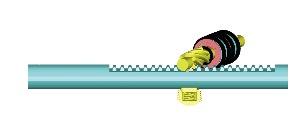ocedure to ensure the proper preload on the rack.
Rack and Pinion Inspection
Some are manual, but most are power assist. Inspect the boots and pinion seal for leaks. If there is a leak or internal problem, the safest approach is to replace the gear with a new or remanufactured gear.
The tie rods are directly connected to the rack gear assembly. A ball joint connects the tie rod to the rack and a tie rod end, which is also a ball joint that attaches to the steering knuckle. These applications require a special tool to remove the ball joint from the rack without damaging a seal on the power cylinder. The center take off steering gear uses rubber bushings to attach the tie rods to the center of the rack housing.
Electronic power steering (EPS) will probably replace the current hydraulic power steering on most vehicles. The transition from hydraulic assist to electric motor assist will provide the driver with a more positive feel and control throughout the entire speed range of the vehicle. EPS systems eliminate the need for a pump, hoses and a drive belt connected to the engine using variable amounts of power. The configuration of an EPS system can allow the entire power assist system to be packaged on the rack and pinion steering gear or in the steering column. The steering system is more energy efficient.
A sensor is located in the steering column to measure steering wheel position and speed. A second sensor is located on the torsion bar of the motor assembly to measure torque or steering effort input to the steering wheel (Figure 5). The controller processes the steering effort, wheel position and speed inputs with a series of software programs called algorithms to produce the polarity and current flow to the motor. The steering wheel can be referred to as a hand wheel in service information. The inputs from the steering controller are also shared on the controller area network (CAN) buss. These inputs will affect other chassis control systems such as anti-lock brakes (ABS) and electronic stability control (ESC).
(Figure 5). The controller processes the steering effort, wheel position and speed inputs with a series of software programs called algorithms to produce the polarity and current flow to the motor. The steering wheel can be referred to as a hand wheel in service information. The inputs from the steering controller are also shared on the controller area network (CAN) buss. These inputs will affect other chassis control systems such as anti-lock brakes (ABS) and electronic stability control (ESC).
As the requirements for vehicle stability controls move forward, the steering system will become an integral part of the braking and stability control program. This will mean more trouble codes and diagnostics.
Even the most advanced systems for the 2009 model year do not have trouble codes for worn gears, tie-rods or bent parts. It is up to you to make the right call on service.













